mobile View, to the German Version tap the flag


- Valencia (Comunidad Valenciana)
- Autonomous Region of Spain
- until 1707 Kingdom of Valencia and a part of the United Crown of Aragon
• Flag
• Historical and other Flags
• Meaning/Origin of the Flag
• Coat of Arms
• Historical Coats of Arms
• Meaning/Origin of the Coat of Arms
• Map of the autonomous regions of Spain
• Numbers and Facts
• History
• Origin of the Country's Name
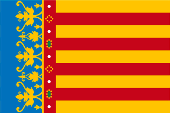
since 1982,
Flag of the Comunidad Valenciana,
ratio = 2:3 also 1:2,
Source, by: Flags of the World






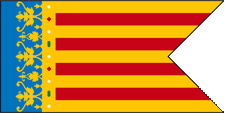
1377 to 18th century,
alleged flag of the Kingdom of Valencia,
Source, by: Wikipedia (CA)



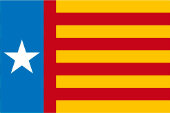
from 19th century, Senyera Estrelada,
Flag of local nationalists,
Source, by: Wikipedia (CA)



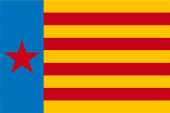
20th century, Esquerra Valenciana,
Flag of local nationalists,
Source, by: Wikipedia (CA)



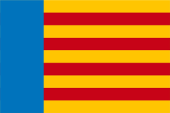
1978–1982,
unofficial flag of Valencia,
Source, by: Wikipedia (CA), World Statesmen



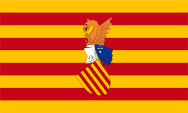
1979–1982,
Flag of the Council of the Country,
ratio – ratio = 3:5
Source, by: Wikipedia (CA)



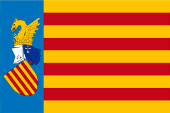
1982,
compromise proposal,
Source, by: Wikipedia (CA)




since 1982,
Flag of the Comunidad Valenciana,
ratio = 2:3 also 1:2,
Source, by: Flags of the World





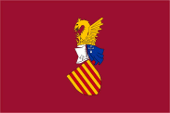
since 1982,
Flag of the Generalitat Valenciana,
ratio = 2:3,
Source, by: Wikipedia (CA)



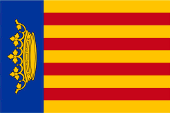
15th to 18th century,
Flag of the City of Valencia,
ratio = 2:3,
Source, by: Wikipedia (CA)




since 19th century,
Flag of the City of Valencia,
ratio = 2:3,
Source, by: Flags of the World





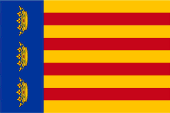
since 15th century,
Flag of the City of Burriana,
ratio = 2:3,
Source, by: Wikipedia (CA)




The current flag of the Region of Valencia (Comunidad Valenciana) was adopted on 10th of July in 1982 as the new flag of the Council of the Region of Valencia. With the adoption of the autonomy status on 4th of December in 1984, this flag was adopted for the autonomous region of Valencia. This flag goes back to the alleged flag of the Kingdom of Valencia. It shows the historical and actually handed down four red bars on gold, but on the mast a blue field with the decorations of the crown of Aragon, separated from the striped field by a red vertical stripe, which is to be understood as part of the crown. This is said to date back to 1377, when King Peter IV., called the Ceremonious, 1336–1387 King of Aragon and Valencia, granted the city the permission to use his golden crown in its coat of arms because of its merits in the Peter's Wars. Since then, the crown has appeared above the city's coat of arms. How was this to be depicted on the flag? Were the kingdom and the city considered separately at that time? Was it not a kingdom with the name of a city, with the city and its surrounding area? If you accept this, then the flag of the city and the kingdom was initially a heraldic flag, what was customary at the time. That is a flag that showed the image of the coat of arms of the country (actually the ruler). In the early days of flags, they were not actually shaped like our flags today. The flags were more like coats of arms, which were attached to the mast with the straight side. Depictions of the flag with the crown on a blue background in a field of the flag on the mast are only found from the 15th century onwards. This was probably just a kind of makeshift solution, because how else could the crown floating above the town's coat of arms be depicted on a flag? The town of Burriana fared similarly, and was even awarded three crowns. In 1707, the Kingdom of Valencia was abolished as a result of the War of the Spanish Succession and the kingdom was divided into 3 provinces, Valencia, Alicante and Castellón. The province of Valencia took over the coat of arms. Regionally charged characteristics lost their importance, so that even the flag was forgotten and a new white flag was created for the city, which showed the Bourbon lily in the centre. After this, the kingdom only existed nominally. The rise of nationalism in the 19th century meant that regional specialities became important again, including in Valencia, so that the flag with the four red bars on gold and the blue field with the decorations of the crown of Aragon became widespread as the flag of the city and region of Valencia. In the political sphere, it was used as a battle flag, as a political symbol, but as the Senyera Estrelada "starry sky flag", without a crown, but with a vertical red stripe. A white five-pointed star appeared in place of the crown. The most important nationalist party was the Esquerra Valenciana, whose Senyera Estrelada flag did not have a vertical red stripe and the star was red. Under the government of General Franco (1936–1975), most regional flags were banned. After Franco's death (1975), regional flags were reintroduced or new ones were created. In 1978, an unofficial flag was created for the slowly emerging region of Valencia, which was based on the historical flag of the city of Valencia with the blue field and the crown, but without the depiction of the crown itself. The Council of the Region of Valencia, which was also constituted in 1978, chose the gold and red stripe flag with the coat of arms of King Peter IV in the centre in 1979. A dispute arose over the authenticity of the flags, and a compromise was proposed: a flag showing the coat of arms of Peter in the blue field of the stripe flag. It was rejected and on 10th of July in 1982, the current flag of the Flag Council of Valencia was adopted and in 1984 it was adopted for the autonomous region of Valencia.
Source: 1. Wikipedia (CA), 2. Wikipedia (CA), 3. Wikipedia (CA), World Statesmen, Volker Preuß

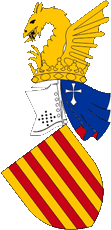
since 1982,
Coat of arms of the Comunidad Valenciana,
Source, by:
Wikipedia (CA)
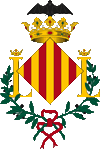
since 1377,
Coat of arms of the City of Valencia,
Source, by:
Macondo, CC BY-SA 4.0, via Wikimedia Commons


14th/15th century,
Coat of arms of the Kingdom of Valencia,
Source, by:
Wikipedia (CA)

14th century,
temporarily/alternatively,
Coat of arms of Valencia,
Source, by:
Wikipedia (CA)

The current coat of arms of the Region of Valencia (Comunidad Valenciana) was established on 17 June 1978, when it was still the coat of arms of the Council of the Region of Valencia. With the acceptance of the autonomous status on 4 December 1984, this coat of arms was adopted for the autonomous region of Valencia. It goes back to King Peter IV., called the Ceremonious, King of Aragon and Valencia from 1336 to 1387, who used it for the first time. With minor changes, it continued to be used until King John II., King of Aragon and Valencia from 1458 to 1479. It shows the inclined coat of arms of the united crown of Aragon with four red bars on gold, above a silvery helmet crowned in gold with a blue helmet cover and a silvery Arista cross on it. The crest is decorated with a winged golden dragon. The winged dragon was important for the region and appears on many municipal coats of arms, but it has changed over the centuries to a bat. In 1707, the Kingdom of Valencia was abolished as a result of the War of the Spanish Succession and the kingdom was divided into 3 provinces, Valencia, Alicante and Castellón. The province of Valencia took over the coat of arms. After that, the kingdom only existed nominally.
Source: Wikipedia (CA),
Volker Preuß

The autonomous regions of Spain:
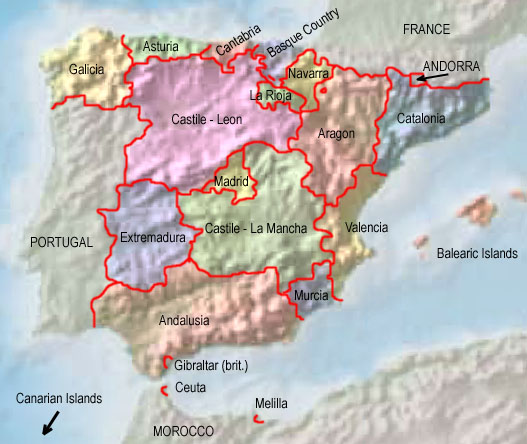
Source: Freeware, University of Texas Libraries, modyfied by: Volker Preuß

Area: 8.978 square miles
Inhabitants: 5.097.967 inh. (2022), mostly Valencians (descendants of Mozarabs and Moresques) and Castilians
Density of Population: 568 inh./sq.mi.
Capital: Valencia, 792.492 inh. (2022)
official Languages: Valencian, Spanish (Castilian)
Currency: Spanish (Euro) currency
Time Zone: GMT + 1 h
Source:
Wikipedia (EN)

early age · settlement by Iberians
ca. 600 B.C. · immigration of Celts, mix with the Iberians, evolution of the Celtiberians, establishment of the greek colony of Turia (the later Valencia)
218–201 B.C. · Second Punic War, the Roman Empire acquires the possessions of Carthago in Iberia, subjugation of whole Iberia until the year 19 B.C.
217 B.C. · the today’s Catalonia comes to the Roman province of Hispania Tarraconensis, Roman settlement, romanization
138 B.C. · foundation of Valentia by D. Brutus, directed settlement of Lusitanians, a Celtic people from the region of the today’s Portugal
ca. 400 A.D. · Great Transmigration (Migration Period), immigration of teutonic Alans, Suebs and Western Goth
415 · to the Empire of the Western Goth
714 · Arabs conquer the region of Valencia, the town gets the name "Medina bu Taral", Arabization, Moslemization, Valencia becomes a province of the Emirate of Cordoba (since 929 Arabian Califate of Cordoba under the dynasty of the Omajjads)
1010 · overthrow of the Omajjads dynasty, to 1040 disintegrates the empire in some arabian kingdoms (Malaga, Algeciras, Granada, Cordoba, Toldeo, Valencia, Zaragoza, Denia, Murcia and Badajoz)
1031 · Muzeik, the arabian proconsul of Valencia, makes the Kingdom of Valencia independent from Cordoba
1094 · the legendary castile national hero El-Cid (el Campeador, really: Rodrigo Díaz de Vivar, 1043-1099) conquers and liberates Valencia
1099 · El-Cid dies in Valencia, the town becomes conquered again by the Arabs
1238 · king Jakob I. of Aragon liberates Valencia again from the Muslims, establishment of the County of Valencia
1319 · Valencia becomes united with Aragon, Catalonia and ten Balearic Islands under the United Crown of Aragon
1469 · marriage of king Ferdinand II. with Isabella, the throne heiress of Castile
1479 · coronation of Ferdinand II. and Isabella I. to kings of Spain
1516 · official unification of Aragon and Castile, but Aragon withholds important privileges
1609 · king Philipp III. of Spain banishes the last Muslims (Moresques) out of the country
1701–1714 · Spanish succession war, Aragon positiones itself at the side of Austria, in 1706 unsuccessful debarkation of British and Dutch troops, after the defeat of the Austrian Part end of the independent kingship of the United Crown of Aragon in 1707, loss of the privileges, Catalonia, the Balearic Islands and Valencia become outsourced as Spanish provinces, Aragon (in its today's borders) and Valencia withhold nominally the title of a kingdom, Catalonia becomes nominally the Principality of Barcelona, the Kingdom of Valencia is divided in the provinces of Alicante, Valencia and Castellón de la Plana
1808–1811, 1812–1813 · Valencia is occupied by French troops
1833 · the until that point in time in Spain existing partial kingdoms and regions become divided in provinces
1931–1939 · statute of autonomy for Valencia within Spain
1936–1939 · Spanish Civil War, Valenica fights – especially in the south – until 1939 on the side of the socialistic governmental troops
10th of July 1982 · Valenica gets the statute of autonomy within Spain (by summary of the provinces of Alicante, Valencia and Castellón de la Plana), establishment of the "Autonomous Community of Valenica"
Source: Wikipedia (ES),
World Statesmen,
RetroBib Retrobibliothek,
Volker Preuß

The name of the city and the region of Valencia has its roots in the Roman colony of Valentia. In the year 138 B.C. the city was revitalized as Roman colony by D. Brutus and it was named Valentia. The word "Valentia" has its roots in the Latin word "valens" what means "healthy, strong or lively". Valentia is in this way "the Healthy".
Source: Handbuch der geographischen Namen


![]()










































